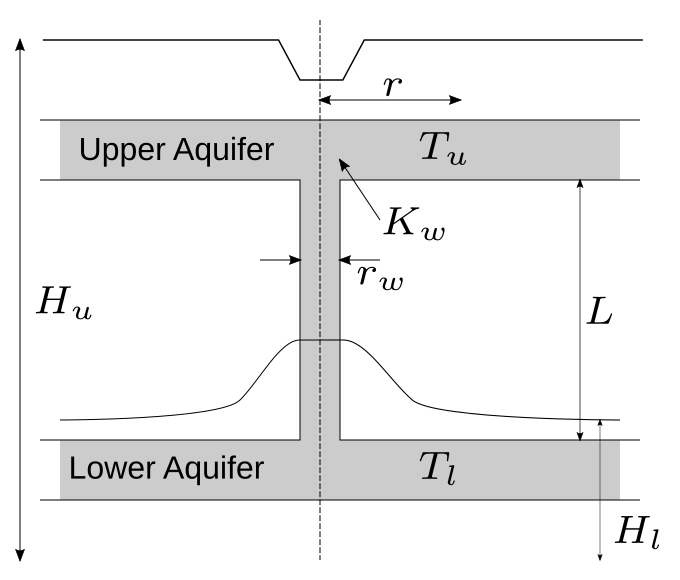The original post can be found here.
The 8-dimensional borehole function models the water flow through a borehole that is drilled from the ground surface through two aquifers. The water flow rate is described by the borehole- and the aquifer’s properties. The borehole function is typically used to benchmark metamodeling and sensitivity analysis methods (Harper and Gupta, 1983; Morris, 1993; An and Owen, 2001; Kersaudy et al., 2015).
Description
The water flow rate through the borehole (Q) is computed using the following analytical expression:
where \mathbf{x} = \{r_w, r, T_u, H_u, T_l, H_l, L, K_w \} is the vector of input variables defined below. The configuration of the scenario of the water flow is illustrated in Figure 1.
Figure 1: Illustration for the water flow through a borehole, adapted from Harper and Gupta (1983).
Inputs
For metamodeling applications (e.g., Harper and Gupta, 1983) the eight input variables of the borehole function are modeled as independent Gaussian, lognormal, and uniform random variables with specified parameters and ranges shown in the table below.
| No | Variable | Description | Distribution | Parameters |
|---|---|---|---|---|
| 1 | r_w | Radius of borehole [\text{m}] | Gaussian | \mu_{r_w} = 0.10, \sigma^2_{r_w} = 0.0161812 |
| 2 | r | Radius of influence [\text{m}] | Lognormal | \lambda_r = 7.71, \xi_r = 1.0056 |
| 3 | T_u | Transmissivity of upper aquifer [\text{m}^2/\text{year}] | Uniform | [63{,}070, \, 115{,}600] |
| 4 | H_u | Potentiometric head of upper aquifer [\text{m}] | Uniform | [990, \, 1{,}100] |
| 5 | T_l | Transmissivity of lower aquifer [\text{m}^2/\text{year}] | Uniform | [63.1, \, 116] |
| 6 | H_l | Potentiometric head of lower aquifer [\text{m}] | Uniform | [700, \, 820] |
| 7 | L | Length of borehole [\text{m}] | Uniform | [1{,}120, \, 1{,}680] |
| 8 | K_w | Hydraulic conductivity of borehole [\text{m}/\text{year}] | Uniform | [9{,}885, \, 12{,}045] |
Other literature (Morris et al., 1993; An and Owen, 2001; Kersaudy et al., 2015) put alternative distributions on the variables r_w and r (while leaving the other distributions unchanged) as shown in the table below.
| No | Variable | Description | Distribution | Parameters |
|---|---|---|---|---|
| 1 | r_w | Radius of borehole [\text{m}] | Uniform | [0.05, \, 0.15] |
| 2 | r | Radius of influence [\text{m}] | Uniform | [100, \, 50{,}000] |
Resources
The vectorized implementation of the borehole function in MATLAB, as well as the script file with the model and probabilistic inputs definitions for the function in UQLab, can be downloaded below:
uq_borehole.zip (3.1 KB)
The contents of the file are:
| Filename | Description |
|---|---|
uq_borehole.m |
vectorized implementation of the borehole function in MATLAB |
uq_Example_borehole.m |
definitions for the model and probabilistic inputs in UQLab |
LICENSE |
license for the function (BSD 3-Clause) |
Open-access repository
The dataset used in this benchmark study is titled “Benchmark case datasets - Borehole function” and is authored by Adéla Hlobilová, Stefano Marelli, and Bruno Sudret. It was published in 2024 and is available on Zenodo. The dataset can be accessed directly via the following DOI link: 10.5281/zenodo.12687184.
The experimental designs include datasets with 40, 80, 120, 160, and 200 samples, each generated using optimized Latin Hypercube Sampling (LHS) with 1{,}000 iterations to improve the maximin criterion. Each dataset is replicated 20 times. The validation set contains 100,000 samples generated by Monte Carlo simulation. Each dataset contains samples and responses of the computational model.
For citation purposes, please use the following format:
Hlobilová, A., Marelli, S., and Sudret, B. (2024). Benchmark case datasets - Borehole function. Zenodo. Surrogate Modeling Benchmark - Borehole function.
This project was supported by the Open Research Data Program of the ETH Board under Grant number EPFL SCR0902285.
References
- W. V. Harper and S. K. Gupta, “Sensitivity/Uncertainty Analysis of a Borehole Scenario Comparing Latin Hypercube Sampling and Deterministic Sensitivity Approaches”, Office of Nuclear Waste Isolation, Battelle Memorial Institute, Columbus, Ohio, BMI/ONWI-516, 1983. URL
- M. D. Morris, T. J. Mitchell, and D. Ylvisaker, “Bayesian design and analysis of computer experiments: Use of derivatives in surface prediction,” Technometrics, vol. 35, no. 3, pp. 243–255, 1993. DOI:10.1080/00401706.1993.10485320
- J. An and A. Owen, “Quasi-regression,” Journal of Complexity, vol. 17, pp. 588–607, 2001. DOI:10.1006/jcom.2001.0588
- P. Kersaudy, B. Sudret, N. Varsier, O. Picon, and J. Wiart, “A new surrogate modeling technique combining Kriging and polynomial chaos expansions – Application to uncertainty analysis in computational dosimetry,” Journal of Computational Physics, vol. 286, pp. 103–117, 2015. DOI:10.1016/j.jcp.2015.01.034
